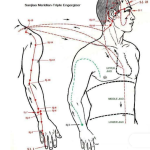This qigong exercise is called “Hold the sky with both hands to manage the Sanjiao“.
What is Sanjiao?
‘Sanjiao’, also called ‘triple burner’ is located in the cavity between the body and viscera, including the chest and abdomen ( based on classic Chinese Medicine). It includes three parts called the upper burner, middle burner, and lower burner as is shown in Figure on the left.  The internal organs above the upper horizontal line in the diaphragm are the upper burner, including the heart and lungs; the internal organs below the upper horizontal line to the umbilical cord are the Zhongjiao (middle burner), including the spleen, stomach, liver, and gallbladder; the internal organs below the umbilical cord are the lower burner, including the kidney, large intestine, small intestine, and bladder.
The internal organs above the upper horizontal line in the diaphragm are the upper burner, including the heart and lungs; the internal organs below the upper horizontal line to the umbilical cord are the Zhongjiao (middle burner), including the spleen, stomach, liver, and gallbladder; the internal organs below the umbilical cord are the lower burner, including the kidney, large intestine, small intestine, and bladder.
How does it prevent and reduce chronic pain?
One possible cause of chronic pain is due to blocked meridians. When there is a blockage in your meridians, the communication in your body system becomes stagnant. This will wreak havoc on the meridian flow and therefore dysregulate the whole system resulting in illness and chronic pain. Have you heard that someone who lost a foot can still feel the pain of the non-existing foot? This is because the brain tries to communicate with the foot but can’t get the feedback, therefore, sending the pain signal as a warning. The same reason for some chronic pain.
This Qigong exercise is designed to stretch your limbs and torso while working in harmony with your breath. This practice promotes the flow of vitality and water throughout your body, as well as the rise and fall of Qi. It helps to regulate the triple burner and unblock the Ren and Du channels, along with the three Yin and three Yang meridians in your hands and feet, and the related segments of your spine. Additionally, it expands the thorax, stretches, and massages the abdominal and pelvic organs, enhances the circulation of qi and blood, and boosts the functions of your internal organs. It’s particularly effective in preventing shoulder issues and cervical spondylosis.
How to do it?
You can follow the movement in this video. Here is the description of the movements:
- start with a horst stand: step your left foot to your left with your shoulder wide, slightly bend your knees, so your upper body is straight, and relax your shoulders and hips, Your hands are in front of your hip bone and elbows point to each side,
- Turn your palms up, move to the front of your belly button, and interlock your fingers,
- move your palms up and your eyes follow your hands’ movement. When moving to your chest level, slowly turn your palms, and continue to lift your hands up meanwhile slowly straightening your knees;
- when your hands are above your head, gently push your palms upwards, then lower your jaw and look ahead, feel the stretch of your wrist, arms, legs, and entire body, pause, and have one or more deep breaths;
- Then separate your hands and move your hands slowly down to each front corner, your wrist slightly bent upward. When moving your hands down slowly bend your knees.
- When your hands are down to your waist level, repeat 1-6.
Key technical points to remember:
- Hold the palms on the chest to stretch the body, pull up and down to lengthen, stretch out the joints, and grasp the ground with the toes.
- When moving your hands down, loosen the waist and sink the hips, sink the shoulders and drop the elbows, loosen the wrists and stretch the fingers, and keep the upper body upright.
- Breathe deeply only when you pause the movement and your hands are pushed up, breathe naturally when you are moving your hands.
Perform this exercise several times each day, and you’ll notice a change. In particular, after doing it 8-10 times consecutively, your hands will become quite warm. You’ll experience a sense of relaxation and comfort, and significantly improved sleep quality.
If you want to learn more about Qigong, and the meridian system, I recommend checking out the book “Qigong for Better Mind and Body Health” available on Amazon. Here is a free sample of this book.

Thank you for another excellent article. The place else could anybody get that type of information in such an ideal means of writing? I have a presentation subsequent week, and I’m on the search for such information.